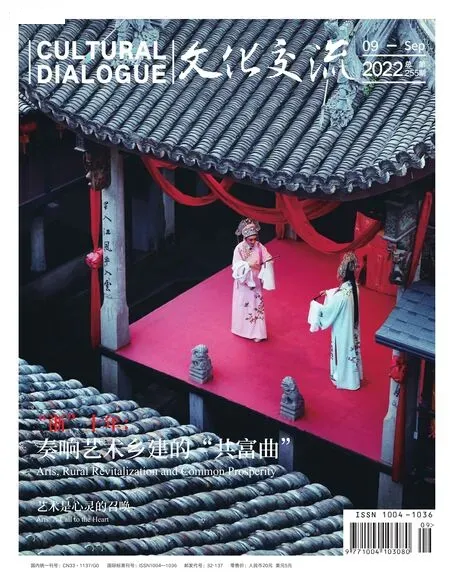千年台州府 老街仍年轻
2022-09-26文/于露
文 /于 露

在台州临海紫阳街,使人难以忘怀的遗存之一便是祖先创造出来的“坊”。In Ziyang Street, Linhai city, a county-level city in Taizhou city, one of the most memorable historical legacies is the fang (or quarters) created by ancient Chinese.
穿过江南长城弯月形的瓮城,半藏在星巴克门店身后的紫阳老街便遥遥在望了。
青砖黑瓦,黄发垂髫,台州府城昔日最为繁华的商业街仿佛依旧是数百年前的模样。花白头发的老爷爷拿着草扇坐在店门前乘凉,笑容真挚的大娘从坛中倒出新鲜的酒酿,街上往来的是步伐闲散、衣衫素朴的居民,依次入目的是里坊形制、外表斑驳的酒楼茶肆。
紫阳街位于台州府城之中,始建于晋,成于隋唐。台州府东临东湖,北环北固,南临灵江,山水秀丽,城廓雄险,素有“江南八达岭”之美誉。台州府城墙又称“江南长城”,自明朝倭寇袭扰频发,台州府成为了守护边疆的重镇,民族英雄戚继光曾在此处练兵12年,抵御外侮,镇守一方。如今,行走在历经鲜血洗礼的历史遗迹中,金戈铁马闻征鼓仿佛仍在耳边激荡,戚家军鸳鸯阵法之玄妙仿佛也仍在眼前变幻,然而在一片人声鼎沸之中惊醒,古城已恢复了往日的盛世之貌。
2022年7月16日,台州府城文化旅游区荣升国家5A级景区。此前,临海市将紫阳古街高品质步行街改造提升与“智慧商圈”改造提升相结合,计划打造具有历史文化展示、体验旅游、特色商业、文化创意、时尚休闲和慢生活特色的历史街区、智慧街区,这一努力已然获得阶段性的成果。
1.5元一个的海苔饼、6块钱一杯的仙草糊、10块钱一盒的乌饭麻糍和蛋清羊尾……如此物美价廉的购物体验常常使游客们感到不可思议。事实上,对于这里的居民来说,紫阳老街就是他们家门口的“小吃摊”,石板路两边,既是商铺,又是民居。“紫阳街这些商铺后面基本都是店主自己平时住的地方,”临海市政府工作人员金樱子介绍说,“游客买东西的地方也是这里居民们买东西的地方,所以价格都不会特别高。这是和其他景区很不一样的。”

当地新晋网红咖啡店的特色咖啡。A cup of coffee made in a popular local coffeeshop at the Ziyang Street.

香气四溢的临海海苔饼刚出炉。The freshly made seaweed cakes.
紫阳街因道教南宗始祖、紫阳真人张伯端得名,是目前国内保存较为完整的一条历史街区,也是公认的“活着的老街”—一代又一代临海人在这里安居乐业、发家致富,临海传统美食和文化也在不断创新之中重新焕发活力、吸引着八方来客。历史与现代、生活与商业交织在这条1080米的长街上,既不会让人觉得破落不堪,也不会显得过分雕琢。
王天顺海苔饼是紫阳街最出名的百年老店之一,也是省级非物质文化遗产代表性项目。四代人接力传承,从1887年王怀富创始,时至今日已是第135个年头。从一天仅卖百余个海苔饼开始,到如今已然可以日销数千个。“不是工作日的时候来要排很久才能买到。”临海市人民政府新闻办副主任汪贵说。
王天顺店铺的门脸并不显眼,门前印着店名的红边黄旗微微褪色,店内则是略显昏暗的白炽灯和老旧的壁挂式电风扇。然而店门的上方却挂着一面气派的巨幅匾额,上面用金黄色的大字写着“台州府城传统小吃”,遥遥招揽着慕名而来的游客。
海苔饼是独具临海特色的地方小吃,金黄的饼皮上是粒粒分明的白芝麻,第一口酥酥脆脆,而细嚼片刻便是绵密的海苔鲜香,咸甜交织的丰富口感在刚刚出炉时即是最佳赏味期。除此之外,售卖乌饭麻糍、蛋清羊尾等传统小吃的店铺也生意火爆,是过往游客绝对不会错过的打卡美食。
而在新晋网红咖啡店18RESERVA(简称18R),台州传统小吃则与咖啡相遇,在传统与现代间碰撞出了奇妙的火花。
桂花酒酿拿铁,在咖啡中加入甜酒酿和桂花蜜;姜汁拿铁,将临海人最爱的姜汁体现在咖啡里;老酒拿铁,把临海灵江梦泉8年陈黄酒与红糖一同熬煮后加入咖啡……在店内菜单中的“我们的创意”一栏,每一种咖啡都是临海特色。
咖啡店木质结构的二层小楼倚在灰墙中间,玻璃门内已是人满为患。“台州限定:乌饭麻糍千层”的海报张贴在门口最显眼的墙壁上,正中是一角可可色的千层蛋糕—软糯麻糍的绵密触感、香甜细腻的豆沙风味、乌饭叶萦绕口腔的清爽香气—将本土食品进行创作和升华,正是18R独特的经营理念。“能够在星巴克百米外的地方开下来,你们知道有多难吗?”金樱子笑道。
18R对本土元素的创新是紫阳老街最具代表性的案例之一,紫阳老街的升级改造也并未牺牲生活的美妙意趣和历史的传统韵味,而是在生活与商业、历史与现代之间找到了一个绝佳的平衡点,从生活中焕发活力,从历史中汲取未来,让紫阳街真正成为一条“活着的老街”。
金樱子出生于临海,对紫阳老街有着说不尽的喜爱。一路走来,街边鳞次栉比的各色商铺她都如数家珍,与她相熟的店主也会挥手招呼她进屋小坐。和她同行的我们同样受到了老板娘的热情招待,也因此得以在37摄氏度的高温中悠然享受了一碗冰冰甜甜的酒酿。
“每年四月份的时候,这里的樱花也很美。”金樱子莞尔一笑说到,“如果有机会,一定要再来一次老街,来逛一逛我们的夜市”。
樱花花谢又花开,市集人往又人来。紫阳街阑珊的灯火在夜色中画上了斑斓的一笔,依稀还是旧时的繁华景象。千年前街边的叫卖声仿佛仍在耳畔,似乎是在回应千年前先人们对子孙后代生活富足的企盼。
Ziyang Street: A Thousand-Year-Old Street Reborn
By Yu Lu
Centuries-old eateries and small shops line closely side by side. Plain-clothed residents pass them by leisurely. A gray-haired grandpa sits in front of his shop shaking a hand-made straw fan to enjoy the cool, while a smiling aunt pours out sweet wine from a mottled porcelain jar and serves the guests. After years of changes,the most prosperous commercial street in Taizhou’s history seems to remain unchanged.
Ziyang Street is the central axis of the Ancient City of Taizhou, located in Linhai, a county-level city in Taizhou city,East China’s Zhejiang province. It wasfirst built in the Jin dynasty(265-420) and completed in Sui (581-618) and Tang (618-907)dynasties. Surrounded by Beigu Hill and Lingjiang River, the majestic city walls earned the reputation as the “Badaling Great Wall in the South”.
In the Ming dynasty (1368-1644), the frequent harassment of Japanese pirates turned Taizhou into a military fortress guarding the southeast frontier of China. Qi Jiguang (1528-1588), widely regarded as one of China’s most prominent national heroes, once trained troops in the city and repelled the pirates.
On July 16, 2022, the Ancient City of Taizhou became a national “5A” level scenic spot, with Ziyang Street serving as one of its centerpieces, where tourists can see history on display, take part in cultural events and enjoy a leisurely life. The effort has already achieved good results.
A mere 1.5 yuan for a piece of seaweed cake, 6 yuan for a cup of grass jelly drink, 10 yuan for a box of black glutinous rice cake and egg-white bread … Such cheap prices andfine shopping experience often make tourists feel incredible. In fact, for the locals,Ziyang Street is exactly the “snack street” in their doorway, since the buildings alongside the street are both shops and dwellings.
“The shop owners on Ziyang Street usually live here too,” said Jin Yingzi, a resident who works at a government agency. “As they are not only catering to tourists, but also serve residents. The prices are quite reasonable, which is very different from many other scenic areas.”
Ziyang Street is named after Zhang Boduan, the founder of the Southern Lineage of Taoism, known as “Immortal Ziyang”. It is a well-preserved historical street and is recognized as a “living ancient street”. Generations of Linhai people live and work here,and the local traditional cuisine and culture are rejuvenated through continuous innovation, attracting visitors from all over the world.
Wang Tianshun Seaweed Cake is one of the most famous shops on Ziyang Street, and the cake itself is also a representative item of provincial intangible cultural heritage. Founded by Wang Huaifu in 1887 and inherited for four generations, the shop is 135 years old now.
“You have to queue for the cake and it takes a long time to get one on non-working days,” said Wang Gui, an official with the local government.
The appearance of the shop is not striking. The red-edged yellow flag with Wang’s name has already faded slightly. Inside the store are dim incandescent bulbs and an old wall-mounted electric fan. The plaque, which reads “Traditional Snacks of Taizhou Prefecture” in large golden characters, attracts tourists from afar.
The seaweed cake is a local snack with unique feature of Linhai. With white sesame seeds sprinkled on the crispy crust, it is very crunchy on thefirst bite, and then the aroma of seaweed will quickly spread out. The combined taste of salty and sweet is the best to enjoy when it just comes out. In addition, shops selling traditional snacks such as black glutinous rice cake and egg-white bread are also popular, which are the delicacy that tourists will never miss.
Born in Linhai, Jin Yingzi has an inexhaustible love for Ziyang Street. Along the way down the street, she is familiar with almost every shop, and shopkeepers who know her well will also invite her to come in and have a chat.
“Every year in April, the cherry blossoms here are also very beautiful,” Jin said. “The old street is worth visiting time and again, and our night fair is quite fantastic as well.”
